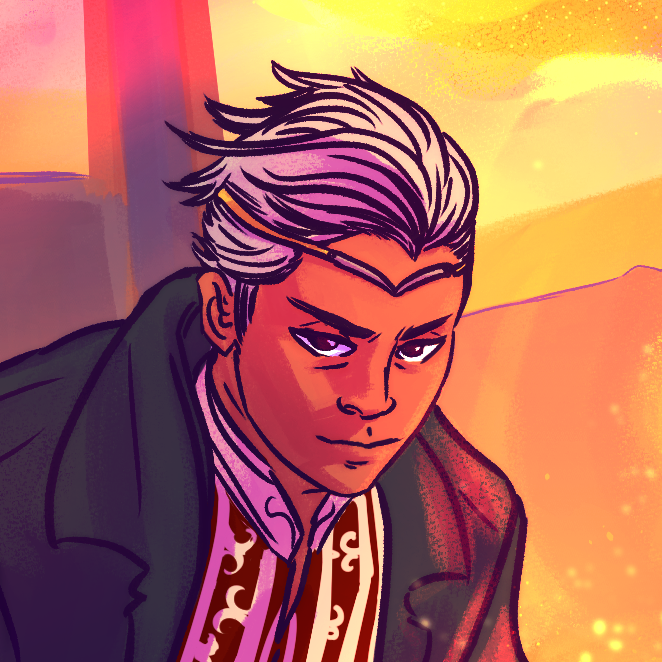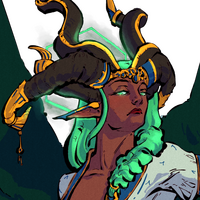
The beggar's sap fungus spends much of its time not visible to the casual observer. It grows under the bark of coniferous trees in northern Caia; peeling up the bark reveals a thick mat of white hyphae. In the summer months, thick yellow liquid seeps out from infected trees; this viscous fluid contains millions of fungal spores. It sticks to the fur of tree-dwelling animals, who spread the fungus to new trees.
The painted stinkhorn is endemic to the tropical rainforest of the country of Helvia. It gets its name from the bright colours - oranges, reds, and pinks - of its fruiting body. Starting off as a yellow 'egg' the size of a clenched fist, the painted stinkhorn bursts forth over the course of one night from the leaf litter, becoming a long, colourful mushroom, reminiscent of a phallus. It is covered with a thick translucent liquid known as the gleba, which smells like a rotting corpse.
The rotten crown fungus grows on dead wood in temperate forests across much of the nothern hemisphere. The spores can lie dormant for several months waiting for rain, after which a circular mass of small fruiting bodies rapidly grow within a period of two to three days. Small and round, the mushrooms are soft grey in colour and damp to the touch. After a few more days, they release their spores and then dissolve into liquid; the nutrients are absorbed back into the hyphae to prepare for the next rainfall.
The giant puffball is a fungus that is found all over the globe in temperate regions. Their fruiting bodies can grow up to one metre across, round white balls that seem to sprout from the ground in late summer and early autumn. When they are white and firm, they are edible, and also have antihaemorrhagic properties that make them useful for wrapping wounds, either in powdered or sliced form. When they mature, the insides turn a brownish green, and they will explode with spores when pressure is put on them. At this point, they are dangerous to eat. One giant puffball can contain several trillion spores.
The trickster's lantern is endemic to the remote tropical island of Caton, located in the Sinien Ocean. It grows in leaf litter, producing fruiting bodies almost all year round. Much of its hyphae spreads out over the surface of the ground, with only around a third of the mycelium growing deep and strong to root the fungus. The actual mushrooms let off a soft glow, only visible in the dark, which attacts insects such as moths. The trickster's lantern secretes a strong paralytic, so when an insect lands on its cap, they will become paralysed and fall onto the ground below. The surface hyphae produce digestive enzymes, slowly absorbing insects that have been caught by its caps.
The most widely cultivated fungus in the world, the common mushroom is known by a variety of names, with many distinguishing between mature and immature examples of the species. Mature mushrooms have an open light brown cap, paling towards the edges, whilst immature specimens are darker brown with a closed cap. Their flesh is white and firm and has a mild taste. In the wild, they are found in fields or grassy areas after rainfall, and are found on the continents of Aenica, Caia, and Sarsand.
The fly agaric is widespread across the northern hemisphere of Etrea, in season during the autumn months. The caps of the mushroom are bright red in colour with whitish spots, distinctive against the floor of the woodlands they grow in. When raw, these mushrooms are toxic and can cause vomiting and delirium, though they are safe to eat if boiled. In various cultures, a ring of fly agaric mushrooms is considered to be a portal to another realm, and they are eaten in Coranir to commune with the dead.
The finder's folly fungus is closely related to the fly agaric; in fact, the two species are almost indistinguishable. Both are bright red with white spots, but where the fly agaric's gills are free, the finder's folly's are adnate. Finder's folly mushrooms are exceedingly poisonous, with one small piece containing enough toxin to kill ten adult humans. They are found exclusively on the continent of Caia.
The wolf fur fungus is found across much of the continent of Sarsand, growing on fallen trees and dead wood. It grows in large patches formed of soft, fur-like bristles, rapidly advancing up to an inch a day. They are pale yellow in colour, turning white with age. Though they are both edible and full of nutrients, their taste has been likened to sucking on a damp, dirty sock. They are used medicinally in fortifying broths to nurse a person through sickness, or in cases of malnutrition.
The recurved prince is a large bracket fungus that grows exclusively on the prince's nutmeg tree in the Helvian rainforest. It has a cup-like fruiting body with a recurved lip, and can remain in bloom for up to two months. During this time, it collects rainwater, forming pools in each mushroom. This serves as the nesting place of the Helvian tree frog, which lays its eggs in the water. After the tadpoles hatch and metamorphose, a secretion in their skin triggers the recurved prince to begin to decay, which in turn coats the froglets in their spores.
The cordyceps lagoms is endemic to the thick swamps of Nor. Like other cordyceps fungi it is parasitic, its mycelium taking over its host's tissues after its spores find purchase. Unlike other cordyceps fungi, the cordyceps lagom's preferred hosts are small mammals such as rabbits or mice. They enter their host through water sources that have been infected with spores. As the fungus matures, it begins to take over some of its host's systems, eventually driving them towards water after the fruiting bodies erupt from their skin.
Like other lichens, the salt crust lichen is considered to be a single species even though it is created via a mutualistic relationship between algae and fungi. The salt crust lichen is native to Sarsand, where it grows on the rocky walls of coastal caves. It is an endolithic lichen, growing in a thick crust-like structure that is nearly impossible to pry off without damaging either rock or lichen. It is dark grey in colour, with white edges along each brancing crack.
Like other skincap fungi, the weeping skincap is the unsettling pink of pale meat. Its tall, peaked cap is made of spongy, spore-bearing flesh, covered by a thin layer of smooth skin. When the fungus has ripened, the flesh slowly turns to slime and the skin sloughs off, leaving behind a dripping stalk. The dark brown goo is highly sticky and attaches itself to any creature that wanders by in order to spread its spores.
The orange peel fungus presents as many small, round, bright orange fruiting bodies the size of a pinhead. It is common in much of the continent of Sarsand, and thrives on damp and rotting wood. Whilst it is most common to find this fungus out in the forest, it also can grow on the wooden supports of buildings. If the orange peel fungus is visible inside a building, it is often a sign of a much more serious underlying damp problem.
The stepping stone fungus is endemic to the rainforests of Esteos. It is a large, flat mushroom that is greyish brown in colour, and can grow up to three feet wide. Many small mammals use them as shelter during the frequent rainstorms. They are strong enough for an adult human to stand on them. Whilst they are technically edible - as in, not poisonous - they taste like faeces. Oddly, they have a mild, spicy scent that has led many a person astray.
The spider crown is a type of cordyceps fungus endemic to the rainforests of Zenra. It infects a specific species of spider known as the lapis tarantula, slowly taking over its body, sapping its nutrients, and eventually controlling so it dies in a suitable place. Once the spider is dead, the fruiting bodies sprout from its head; they are long, thin, and twisted, and give the appearance of a crown. It is are extremely rare and difficult to find, but highly coveted for its purported aphrodisiacal properties.
The volcanic truffle grows only on the ash-covered slopes of the Gulguns, the volcanic mountain range on the continent of Sarsand. This fungus can lay dormant for decades, growing only after an eruption when they have been covered in hot ash - lava will kill the spores. The heat of the ash stimulates growth, producing round black truffles that are, on average, the size of an adult human's fist. They have a delicious smoky flavour, but are extremely hard to find.
The violet inkcap is endemic to southern Viretia, specifically the country of Fluvansii. It grows in the geothermal caves common in the region, thriving around the edge of boiling pools of water. It gathers nutrients from the minerals that form colourful crusts around these pools. The violet inkcap itself is a couple of inches high, with a pointed cap, and is a deep purple in colour. They are harvested by the Fluvans for the creation of dye.
The pebble fungus grows on beaches just above the high tide line, its mycelium tunneling deep - almost two metres - beneath the sand and rock to ensure a sturdy grip. It is often camouflaged amongst the rocks and pebbles when it is blooming, as the fruiting body looks like a fist-sized grey stone. This protects it from being eaten by scavengers.
The delicate princess is one of a genus of carnivorous fungi, cryptus, that use mimicry in order to attract their prey. When blooming, it looks like a dainty pink flower with a sweet and beguiling scent. This attracts various insects to land on its 'petals', which are covered in a slick secretion known as sondum. This makes the insect slip into the core of the fungus, where it is digested.
The faerie's parasol is a delicate, blush-pink fungus that only grows on the island of Vale. It has a conical cap, with the light pink darkening towards the tip. They are small, rarely more than a couple of inches high, and occur is small clusters around the roots of trees. In folklore, they serve as shelters for faeries. They are extremely poisonous, with death occurring within one hour of ingestion.
The chunky flap is a bracket fungus common on the continent of Sarsand. It grows on the rough bark of coniferous trees, the biggest mushrooms growing to around a handspan in size. Known for being tasty, they are harvested and used in a variety of local cuisine. They have a strong nutty flavour.
The golden disc fungus grows at the foot of oak trees, found on all continents except the Frozen North and the Barren. It has a mutalistic relationship with the oak, its mycelium growing around the trees' roots, sharing nutrients between the two species. It has a round, flat yellow cap. It is believed to promote healthy circulation, used in traditional medicine across several countries.
The birdcage fungus is a type of stinkhorn endemic to the island of Anglas. The fruiting body starts life as a deep purple 'egg', which can lie dormant for up to a month. It then bursts open when the temperature is just right, forming an intricate, lace-like, spherical structure that is pale yellow in colour. Its foul odour attracts insects that spread its spores.
The potato fungus is a type of puffball mushroom that grows in fields, its fruiting bodies bearing an uncanny resemblance to potatoes. These fruiting bodies are firm, dense, and heavy, and have been proven to be the fatal weapon in more than one murder case. Once ripe, they rot quickly, turning into a puddle of sticky brown goo. An individual fungus can grow to up to a mile wide and can pop up dozens of mushrooms.
The ashy baby fungus is endemic to the Black Forest in southern Serukis. Across the country, the grey mushrooms are highly sought after; their spores are a key ingredient in the popular and expensive alcoholic drink known as 'tempest'. Its harvest season is responsible for no small amount of deaths due to its competitive nature.
The fog cap is is a dark grey mushroom that grows in damp leaf litter on the continent of Viretia. Though it has a sweet, honey-like flavour, it is not advised to eat it as it can cause serious digestive issues. People in the country of Roshan sometimes use it as a cure for constipation and, although it does work, it often causes more harm than good.
The black veil is a stinkhorn fungus that is widespread across the countries of Serukis and Caillah. It begins as a small black 'egg', before bursting into a pointed cap with an intricate black veil dangling from its rim. When squeezed, thick black slime seeps from it. This slime is used in the creation of lel'a ko, the ink used for lelashan, the cultural tattoos of the Koushan Mai.
The bitterball fungus is common across the north of Caia, especially in the countries of Ilwyrika and Achia. It is a solid brown mushroom about the size of a fist, found nestled in the roots of trees. It has a bitter, unpleasant flavour, though it is full of nutrients and high in calories; as such, it makes for a good source of food in an emergency. When carefully dried, the mushroom burns long and low, and is useful for getting fires going.
The oozing mat is a bright yellow slime mould that lives in the Draconic Caverns of Serukis. It generally grows to around the size of a dinner plate, though larger specimens have been observed. It moves slowly across the cave floor at the speed of several metres per day. It secretes acid and absorbs minerals from the surrounding rocks, though will happily feed off a carcass if it comes across one.
Etrea © Emily Vair-Turnbull 2020-24
Images © Emily Vair-Turnbull unless stated otherwise | CSS Theme © TJ Trewin
Etrea Logo © Grace Gittel Lewis | Etrea World Theme © Elias Alija
Images © Emily Vair-Turnbull unless stated otherwise | CSS Theme © TJ Trewin
Etrea Logo © Grace Gittel Lewis | Etrea World Theme © Elias Alija
Cover image:
by
Landon Parenteau
Comments
Please Login in order to comment!










There are so many! :D I love it!
Thank you! :D
Explore Etrea